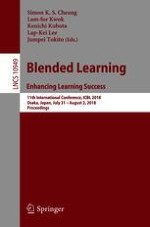2018 | Book
Blended Learning. Enhancing Learning Success
11th International Conference, ICBL 2018, Osaka, Japan, July 31- August 2, 2018, Proceedings
Editors: Simon K.S. Cheung, Lam-for Kwok, Kenichi Kubota, Lap-Kei Lee, Jumpei Tokito
Publisher: Springer International Publishing
Book Series : Lecture Notes in Computer Science
